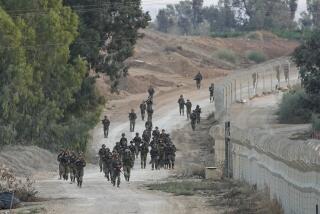Get Ready for More Targeting Disasters
- Share via
What happened when the Chinese embassy in Belgrade was mistakenly bombed by NATO forces was just the tip of the iceberg in terms of what could happen in the future. The fact is, the method for investigating possible bombing sites--once the purview of the CIA--has been seriously degraded under the current methods of analyzing data.
Since October 1996, when the CIA was told by Congress to turn its imagery components over to the Department of Defense’s National Imagery and Mapping Agency, there has been loss of key personnel and a lack of coordination between the intelligence and operational communities. This has left the United States and its allies vulnerable to making catastrophic errors like bombing the Chinese embassy. Congress must rethink how things are done or tragic mistakes will continue to happen.
In late 1993, the CIA established a multidisciplinary office for coordinating all agency targeting support to the Joint Chiefs of Staff and the unified commands. The Central Targeting Support Staff drew personnel from the agency’s three main directorates--intelligence; science and technology, and operations. CTSS’ role was to solicit target-specific information from each component of the agency that might have militarily useful data. The CTSS was responsible for gathering targeting information and making sure it got to the Joint Chiefs of Staff.
As the CIA officer responsible for coordinating the agency’s military targeting support during the 1995 NATO air campaign over Bosnia, I ensured that NATO-sponsored targets were vetted through the appropriate CIA offices. I consolidated all responses and passed on that data directly to the Joint Chiefs’ intelligence unit for transmission to NATO headquarters. On at least one occasion during the Bosnian effort, the CIA was able to persuade the Joint Chiefs and NATO to steer clear of certain targets whose destruction might have further widened the conflict. After the cessation of hostilities, CIA analysts were able to persuade the U.S. European Command to remove Serbian chemical weapons production facilities from their target list after making clear that their destruction could cause significant collateral contamination and loss of life in the city of Krusevac.
But, clearly, in the nearly four years since the end of the Bosnian campaign, the CIA’s targeting support mechanism has broken down.
Published reports on the May 7 Chinese embassy bombing in Belgrade raised several troubling questions. But to date, the obvious question has not been asked: Were any of the former NATO defense attaches to Belgrade asked to take a look at the target list? That simple step--which was the responsibility of NATO supreme commander Gen. Wesley K. Clark and his Supreme Headquarters Allied Powers Europe planners--could have averted the entire debacle. A similar inquiry by the CIA could have produced the correct information. Unless previous standards of coordination are reestablished and maintained, similar avoidable target errors will continue to plague our military operations.
In its June 24 story, the New York Times suggested that the targeting problem rested largely with inaccurate mapping data maintained by the Pentagon’s National Imagery and Mapping Agency. Indeed, there is great cause for concern about the agency’s performance since its creation three years ago. The NIMA-supplied maps were used by the Marine aviators responsible for the Italian cable car disaster--maps that failed to show the presence of the cable car trolley. NIMA also understaffed its India-Pakistan nuclear monitoring effort, thereby missing key Indian preparations for testing a nuclear device in May 1998. Three months later, NIMA supplied the imagery-related data for the U.S. cruise missile strike on the Shifa pharmaceutical plant in Khartoum--a facility the U.S. government now admits had no chemical warfare association, as the imagery of the plant I examined clearly showed (no fencing, no guard towers, no specialized area for hazardous materials storage--all of which would likely be present in a chemical weapons facility). Had the agency’s city plan of Belgrade been properly updated, it is highly unlikely the Chinese embassy would have been struck.
These mapping and imagery analysis-related errors are serious; their pattern suggests inter-organizational chaos, a lack of firm management and a dwindling pool of experienced photo interpreters. Congress must reexamine the rationale for creating the National Imagery and Mapping Agency.
Moreover, the CIA must be asked whether the Central Targeting Support Staff remains the agency’s focal point for targeting support and whether its staffing and organization are adequate to provide the kind of timely, accurate information required for effective military operations.
Unless the American military operational and intelligence communities make full use of all available targeting-related data in the future, we will almost certainly witness more preventable tragedies like the Chinese embassy catastrophe.
More to Read
Sign up for Essential California
The most important California stories and recommendations in your inbox every morning.
You may occasionally receive promotional content from the Los Angeles Times.













